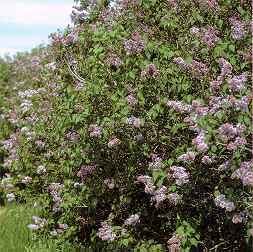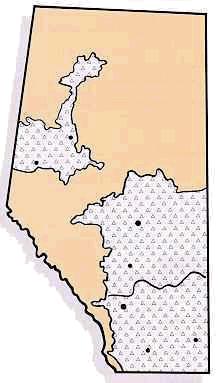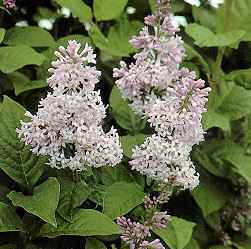| | Plant characteristics | Fall colour | Site preference | Hardiness | Uses | Problems | Insects | Pruning
.

Scientific Name: Syringa villosa Vahl.
Plant Characteristics
Villosa lilac was introduced in North America from Northern China and Mongolia. It performs well in all regions of the prairies.
Villosa lilac is a large coarse shrub, with rapid growth rate when young. Villosa lilac can reach the height of 3 to 5 m (10 to 16 ft), with a spread of 2.5 m (8 ft).
Villosa lilac is a long lived, tall hedge plant. It can live 50+ years. Its growth rate can vary from 5 to 30 cm (2 to 12 in.) a year.
Leaves - are simple, elliptical to oblong in shape, from 5 to 15 cm long (2 to 6 in.) and 3 to 7 cm wide (1 to 3 in.). The opposite leaves are dark green, smooth edged and very distinctively veined.
Flowers - Flowers are borne in clusters at the ends of branches during mid and late June, thereby giving its name late lilac. Clusters vary in size from 12 to 15 cm (5 to 6 in.). The florets vary in colour from washed out mauve, pink, fading to white as the flowers mature. The flowers appear approximately two weeks later than common lilac. The period of flowering is short and seed capsules form early July. This lilac is non-suckering and deep rooted, and does not compete with adjacent crops or gardens.
Bark - Tan brown when young.
Fruit - Tan capsule.
Fall Colour
Villosa lilac turns yellow.
Site Preference
Villosa lilac performs best in well drained clay or loam soils. It does not perform well in sandy soils and will not tolerate poorly drained sites. It often requires more care than other species during the establishment period, but will grow in a wide variety of soils.
Villosa lilac is very drought resistant.
Grows best in full sun, can tolerate some shading. Requires full sun for maximum bloom quality, tolerant of moderately alkaline soils.
Hardiness
Winter hardy.
.


Uses
Villosa lilac is most suitable for the outer row of farmstead shelterbelt, or single row roadside or field belt. In field belts, lilac provides cover for wildlife. The branches and seeds are seldom used for food by wildlife.
The fact that late lilac does not sucker is often considered to be an advantage of this shrub. It has less value as an ornamental than common lilac. Spacing recommendations are 1 to 1.5 m (3 to 4.5 ft) in the row, in multiple-row plantings the lilac should be planted 5 to 8 m (16 to 26 ft) away from adjacent row of trees.
Problems
Lilac seed germination can lead to a weedy appearance.
Insects
Attacked by borers, scale insect, leaf miner.
Pruning
Remove large wide spreading branches to keep the shelterbelt in bounds.

Shelterbelts Varieties for Alberta provides information on a number of other trees and shrubs than may be suitable for shelterbelts.
Visit our website directory for the Reforestation Woodlot Listings. |
|